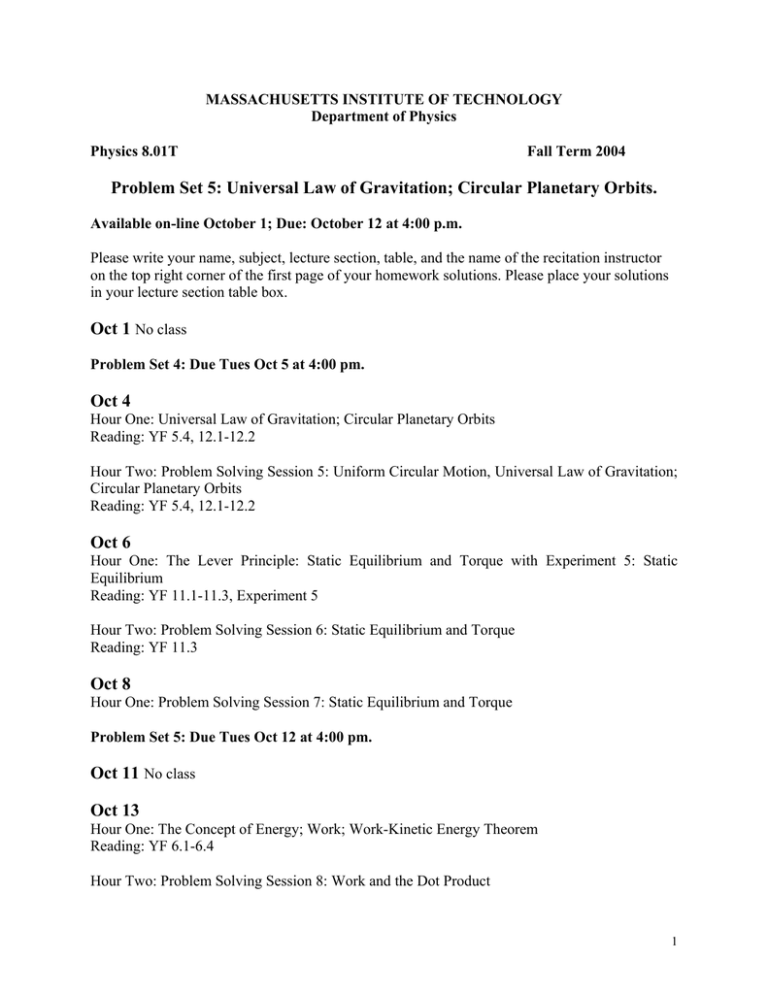Problem Set 5: Universal Law of Gravitation; Circular Planetary Orbits.
advertisement

MASSACHUSETTS INSTITUTE OF TECHNOLOGY Department of Physics Physics 8.01T Fall Term 2004 Problem Set 5: Universal Law of Gravitation; Circular Planetary Orbits. Available on-line October 1; Due: October 12 at 4:00 p.m. Please write your name, subject, lecture section, table, and the name of the recitation instructor on the top right corner of the first page of your homework solutions. Please place your solutions in your lecture section table box. Oct 1 No class Problem Set 4: Due Tues Oct 5 at 4:00 pm. Oct 4 Hour One: Universal Law of Gravitation; Circular Planetary Orbits Reading: YF 5.4, 12.1-12.2 Hour Two: Problem Solving Session 5: Uniform Circular Motion, Universal Law of Gravitation; Circular Planetary Orbits Reading: YF 5.4, 12.1-12.2 Oct 6 Hour One: The Lever Principle: Static Equilibrium and Torque with Experiment 5: Static Equilibrium Reading: YF 11.1-11.3, Experiment 5 Hour Two: Problem Solving Session 6: Static Equilibrium and Torque Reading: YF 11.3 Oct 8 Hour One: Problem Solving Session 7: Static Equilibrium and Torque Problem Set 5: Due Tues Oct 12 at 4:00 pm. Oct 11 No class Oct 13 Hour One: The Concept of Energy; Work; Work-Kinetic Energy Theorem Reading: YF 6.1-6.4 Hour Two: Problem Solving Session 8: Work and the Dot Product 1 Reading: YF 6.1-6.4 Oct 15 Hour One: Problem Solving Session 9: Work Done by Friction and other Dissipative Forces; Motion With Dissipative Forces Reading: YF 5.3, 6.1-6.4 Problem Set 6: Due Tues Oct 19 at 4:00 pm. 2 Problem 1: (Second Law Applications: synchronous satellite) A synchronous satellite goes around the earth once every 24 h, so that its position appears stationary with respect to a ground station The mass of the earth is me = 5.98×1024 kg . The mean radius of the earth is re = 6.37 ×106 m . The universal constant of gravitation is G = 6.67 × 10−11 N − m 2 kg 2 . Your goal is to find the radius of the orbit of a synchronous satellite that circles the earth. a) Describe what motion models this problem. Write down a vector description of the acceleration. Clearly indicate your choice of unit vectors and your reasoning for choosing them. b) What is the radius of the orbit of a synchronous satellite that circles the earth? Approximately how many earth radii is this distance? Problem 2: (Circular motion: banked turn) A car of mass m is going around a circular turn of radius R which is banked at an angle θ with respect to the ground. Assume there is a coefficient of static friction µ s between the wheels and the road. Let g be the magnitude of the acceleration due to gravity. You may neglect kinetic friction. In each part below show your force diagrams. a) Describe the motion of the car if the car is traveling very slowly or extremely fast. Is it possible for the car to travel at speeds such that it can undergo circular motion? If so, what coordinate system best suits this problem. In particular, describe the acceleration vector in terms of your coordinate system unit vectors. b) Derive an expression for the minimum velocity necessary to keep the car moving in a circle without slipping down the embanked turn. Express your answer in terms of the given quantities. c) Derive an expression for the maximum velocity necessary to keep the car moving in a circle without slipping up the embanked turn. Express your answer in terms of the given quantities. d) Derive an expression for the velocity necessary to keep the car moving in a circle without slipping up or down the embanked turn such that the static friction force vanishes. Express your answer in terms of the given quantities. 3 Problem 3: Experiment 5 Static Equilibrium Analysis Part a) Suppose a rope of mass m = 0.1kg is connected at the same height to two walls and is allowed to hang under its own weight. At the contact point between the rope and the wall, the rope makes an angle θ = 100 with respect to the horizontal. The object is to find the tension in the rope at the end and at the middle of the rope.In order to find the tension in the rope at the end and at the middle of the rope, you will need to think cleverly what to include as the system in your free body diagrams. Describe a) What choice did you make for the system for you free body force diagram. Show all the forces acting on the diagram. What is the tension at the ends of the rope where it is connected to the walls? b) What choice did you make for the system for you free body force diagram. Show all the forces acting on the diagram. What is the tension in the rope at a point midway between the walls? Part b) A device called a capstan is used aboard ships in order to control a rope which is under great tension. The rope is wrapped around a fixed drum, usually for several turns (the drawing below shows about three fourths turn as seen from overhead). The load on the rope pulls it with a force TA , and the sailor holds it with a much smaller force TB . Show that TB = TAe − µsθ , where µ s is the coefficient of static friction and θ is the total angle subtended by the rope on the drum? Here’s a hint: choose a small mass element of arc length R∆θ . Carefully indicate the forces acting on this section of the rope. Is the tension constant in this section? 4 Problem 4: Static Equilibrium The Knee A man of mass m = 70 kg is about to start a race. Assume the runner’s weight is equally distributed on both legs. The patellar ligament in the knee is attached to the upper tibia and runs r over the kneecap. When the knee is bent, a tensile force, T , that the ligament exerts on the upper r tibia, is directed at an angle of θ = 400 with respect to the horizontal. The femur exerts a force F on the upper tibia. The angle, α , this force makes with the vertical will vary and is one of the unknowns to solve for. Assume that the ligament is connected a distance, d = 3.8 cm , directly below the contact point of the femur on the tibia. The contact point between the foot and the ground is a distance s = 3.6 ×101 cm from the vertical line passing through contact point of the femur on the tibia. The center of mass of the lower leg lies a distance x = 1.8 × 101 cm from this same vertical line. Suppose the mass of the leg is a 1/5 of the mass of the body. a) Explain the origin of the forces that are shown in the above force diagram. b) What are the equations for static equilibrium of the forces? c) About point will you choose to analyze the torques? What are the equations for static equilibrium of the torques? r d) Find the magnitude of the force T of the patellar ligament on the tibia. r e) Find the direction α of the force of the femur F on the tibia. 5




